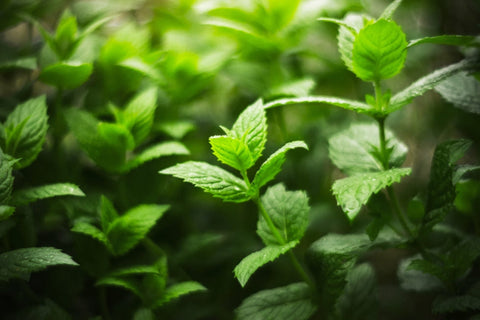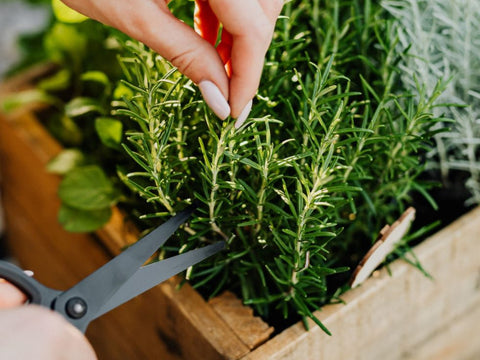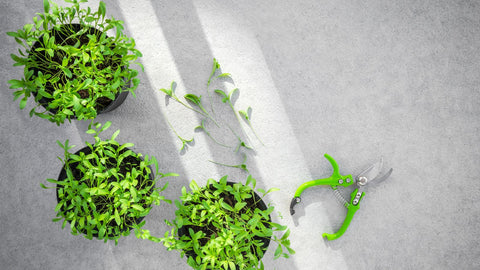Herbs are flavorful, fast, and easy to grow, making them a staple in indoor and outdoor kitchen gardens. Herbs need a fair amount of sunlight—most prefer full sun. That explains why many herbs don’t thrive indoors; there's often not enough light. In this blog, we’ll review the light needs for different herbs, how to see if you have enough natural light, and how to set up a simple but effective grow light.
Light Needs for Herbs
Light drives photosynthesis, which provides the energy for all plant functions. Without enough light, your herbs won’t grow and thrive. Did you know that light quantity and quality also impact herb flavor? That's right, light stimulates the production of essential oils and flavonoids that give herbs their distinct flavor and aroma. Under too little light, flavor and aroma are often less intense.
More importantly, you can't keep harvesting herbs that aren't growing! So, giving your herbs adequate light indoors is a must.
The minimum and ideal hours of direct sunlight for culinary herbs are:

Generally, 6 to 7 hours of sunshine hitting the leaves will provide herbs with enough light to grow well. However, 6 hours is a lot of direct light to get in any window, so depending on your conditions, you might want to look at lower light herbs like mint or parsley. While it’s essential to hit the minimum, you’ll get faster growth with more light. If you want more herbs, the best thing you can do is give your plants more light.
Do I Have Enough Sunlight to Grow Herbs?
Even if a window in your home seems "bright," it may not actually provide enough light for growing herbs. Most windows benefit from supplemental grow lights.

Season & Window Direction
Every home will be different when it comes to exposure and light levels. Generally, south-facing windows offer the most natural light and your best chance for growing indoors with only natural light, though you need to understand some seasonal shifts. In the fall and spring, bright, unobstructed southern windows work well for growing herbs. In the winter, your southern window is still your best bet, but the weaker sunlight might need to be combined with a grow light. In the summer, southern windows can get very hot, so you might need to pull herb plants back a bit from the window, or you might find your sun-loving herbs do just fine in a southern window in summer!
Watch Your Plants
The ultimate test of your natural light will be your plant’s growth or lack thereof. You can tell very early if you don't have enough light—you’ll notice your herbs start to look leggy and stretched. Plus, overall growth will slow down or may stop. If your herbs respond this way, it's time to add a grow light!
Setting Up a Grow Light for Year-Round, Fast-Growing Herbs
Grow lights can be a little intimidating, but they really shouldn’t be! There is a lot of marketing noise to cut through, but at the end of the day, a well-designed grow light provides a 1:1 replacement for sunlight, looks nice in your home, and pays for itself. Plants love the consistency of grow lights, which helps your space be as productive as possible.
The easiest types of grow lights to use are full-spectrum LED spotlights with an E26/27 base, in the 20-40 Watt range. These bulbs can be inserted into most home fixtures, such as the Vita LED Grow Light.
Or you can choose an integrated fixture, such as the SolTech Aspect LED.
How far: Depending on the strength of the grow light, position your LED spotlight anywhere from 6 to 18 inches above your herbs. The closer your grow light is to the plant, the more intense the light delivery (PPFD), but it will also increase the temperature as well.
How long: If you're growing in a southern window, you may only need to run your grow light for 4-6 hours to supplement enough light. If you are not growing in a spot with much natural light, you may run your lamp(s) for 10-12 hours to provide enough light for your herbs.
How many plants: The closer your grow light is to your plants, the smaller the area the light will cover. To light a group of plants, you may need to hang several grow lights to provide enough coverage. At a distance of 6 to 12 inches, you're typically lighting one or two plants. At a distance of 12 to 24 inches, you can light a group of 4-6 plants (approximately).
Your Herbs Will Tell You!
Different herbs will respond differently to light intensity and duration, so always watch your plants! They will tell you quickly if the light is too intense (yellowing and scorching on leaves) or too little (pale leaves, leggy stretched slow growth).
Want to Level-Up Your Indoor Lighting Knowledge?
Read our primer for Grow Lights for Indoor Plants!









There are no comments for this article. Be the first one to leave a message!